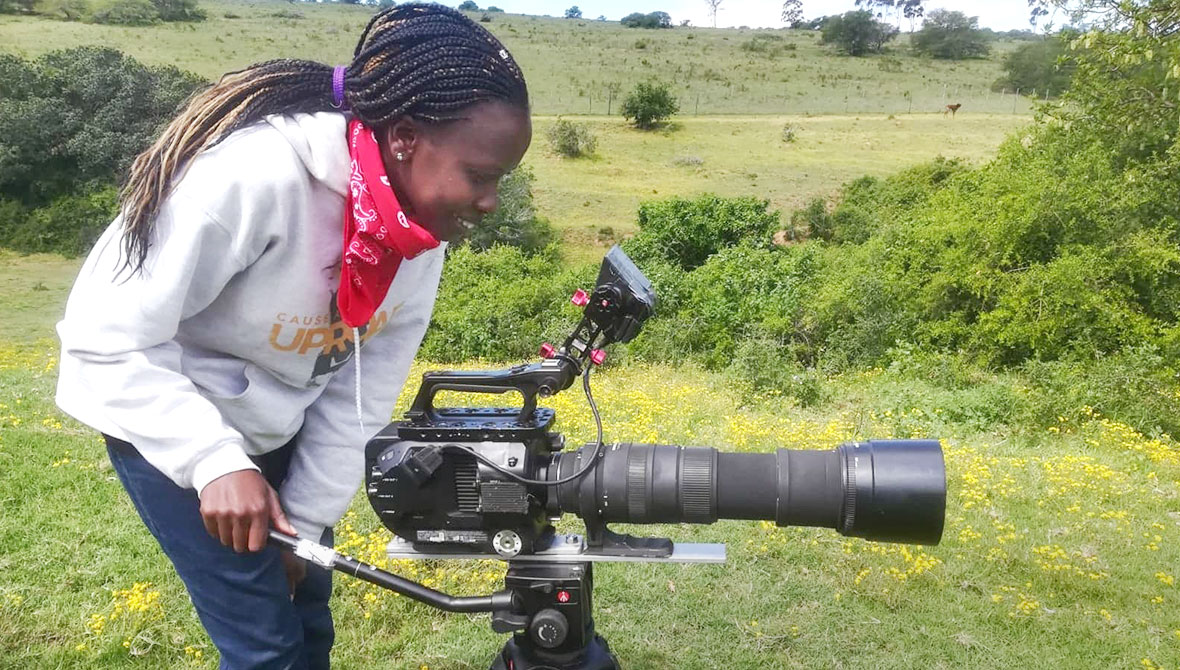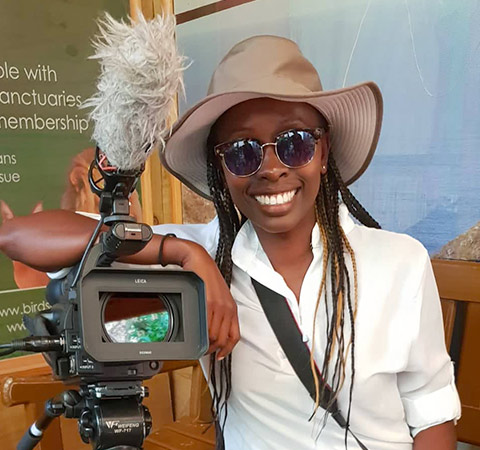Telling African conservation stories from a local perspective

Fiona Tande, judge of the 2022 Benjamin Mkapa African Wildlife Photography Awards, reflects on her filmmaking journey and how African storytellers can shift the conservation narrative.
Between organizing the first-ever wildlife conservation film festival in sub-Saharan Africa and running her production agency Pridelands Films, Fiona Tande is deciding the finalists of this year’s video submissions for the Benjamin Mkapa African Wildlife Photography Awards. Keen on elevating homegrown filmmakers and presenting authentic and nuanced stories, she brings 10 years of wildlife conservation and natural history filmmaking to the judging panel of the Africa in Motion category. Tande shares the impact of mentorship opportunities that transformed her career and how the photography competition, now in its second year, celebrates the continent’s people, wildlife, and natural spaces.
What motivated you to create the Pridelands Wildlife Film Festival?
As a former Jackson Wild Fellow and organizer of the Virtual Summit in Kenya in 2020 and African Conservation Voices last year, I have benefited from having a space for natural history filmmakers to convene. We must be able to exchange ideas, explore how we can collaborate, and share opportunities — but it does not happen on the continent, so I took on the challenge of launching a first-of-its-kind festival for locally made wildlife and conservation-themed films. It has been very rewarding because I am now in spaces that I would ordinarily not find myself, such as the judging panel of the Benjamin Mkapa African Wildlife Photography Awards.
Finally, local storytellers have somewhere to showcase their work and celebrate Africa. Festivals and photography exhibitions also allow creators to interact with their audiences and talk them through the process; they could even connect with potential partners who can make a huge difference in their careers. Additionally, viewers can also exchange their experience of the film or photographs with others, making it an infused learning process for all.
How did you transition from wildlife conservation to natural history filmmaking?
I grew up watching wildlife films and series, but it never occurred to me that I could belong in that space because no one onscreen ever looked like me, even remotely. But they triggered a passion for wildlife, so I figured the next best thing — though unconventional — was community development, which I studied while volunteering in conservation projects. For the next seven years, I worked with people in Kenya’s richest biodiversity havens, including Maasai Mara, Samburu, and Watamu at the coast.
All this time, I was exposed to so many lesser-known conservation stories and knew that film would be the perfect way to capture them. The turning point was attending a month-long film course in South Africa. I have since had the chance to advance the skills learned in the course from further training programs in both terrestrial and underwater cinematography.
Marrying my passion for wildlife with the technical aspects — for instance, how the camera works and getting steady shots — was exciting and intimidating at the same time. My fondest memories are of the thrill of being in the wild with these magnificent animals and being able to capture their stories. Even though I am now a filmmaker, I feel like I am still in conservation but in a different capacity; I was never removed from it.
What is the driving force behind your work as a wildlife filmmaker?
Coming from the Maasai community, I find that while we are celebrated, we are also vilified for some practices. However, our love for wild animals is very much intact, as my cultural heritage and my work as a conservationist continue to prove. We have been conserving even before the word was invented. But this is not always represented in mainstream media; instead, the focus tends to fall on retaliatory killings or lion hunting, which we do not practice anymore.
Correcting this false narrative is at the core of my work at Pridelands Films — eliciting compassion for people that live in and around wildlife areas and presenting the whole picture rather than just one dimension. For instance, communities live in fear of elephant incursions because they can lose their livelihoods in one day after working on their farms for a whole year.
Telling this story from the local perspective is critical in shifting the narrative. Kenya is the site and subject of so many natural history films, but there is hardly ever any local involvement in these productions, and we seldom have access to watch them. This is a travesty that needs correction. When African storytellers are at the writing table and behind the camera, we are the ones who can think of the solutions. We have closer access to these stories than foreign crews, and we also tell the story differently.
Additionally, the natural history films about African wildlife focus on terrestrial landscapes to the extent that people might not realize that there is a whole different world beyond topside ecosystems. Yet the underwater nooks and crannies will equally surprise you. For instance, Kenya hosts twin wildlife migrations every year — one is the widely known wildebeest migration in the Mara but there is also the humpback whale migration in Watamu that takes place at the same time. Our tropical waters are amazing — I cannot stress enough how much there is to learn but not a lot of people have the opportunity to work in Watamu as I did. And so again, film is such an important tool to educate and inform people.

Filmmaker Fiona Tande is a judge of 2022 Mkapa awards video category
What are you looking for in the winning film entries for the Mkapa awards Africa in Motion category?
In the spirit of the Mkapa awards tagline “Bringing Africa to the world, and the world to Africa,” I will definitely be looking out for accurate and authentic depictions of the reality we are experiencing on the continent and also the involvement of locals. If we are striving for people to experience an Africa that they may never visit, then they have to know that this is how we speak, this is what we go through every day. The little details — like hearing a name or voice you recognize — make a huge impact. Without that recognition, the disconnect begins, and a local viewer might think, “This is not a space I identify nor an experience I connect with.”
The Mkapa awards are engaging storytellers from other countries or within the continent and I am so honored to be able to play a small part in making the space more inclusive.
How has the Kenyan film industry changed since 2018?
A huge difference between five years ago and now is that more young African storytellers are exploring natural history filmmaking and wildlife photography. It is more accessible to people who look like them because of the growing drive to involve local storytellers in projects. We are creating platforms to speak about our experiences and gaining more coaching opportunities to help us make our way into the industry.
In the next decade, I foresee us creating our own stories and distributing them on the scale of Planet Earth and The Blue Planet. An influx of African-led stories is certainly on the horizon.
How do natural history or wildlife films make conservation happen?
Watching a film about the plight of lions catapulted me into conservation. Natural history films taught me about the biological characteristics and behavior of wildlife, and the challenges. This is what inspired me to get into the conservation world — and then come back full circle into film.
Film has the capacity to engage on a level that one wants to take action; scientific papers and articles and even conservation programs rarely strike such a visceral connection with most people. Short films are especially compelling in today's busy world — within three minutes, filmmakers can communicate what our wildlife is going through, what we can do, and what we stand to lose. It forces us to answer the question of where we want history to find us — on the side of the people who did not do anything or those who joined the movement towards conservation.